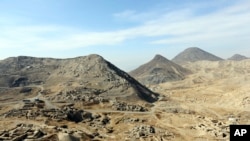The international community is renewing its focus on Afghanistan’s mineral wealth, believed to be worth more than $1 trillion, lying untapped within its often-hostile geography.
This comes as the newly formed Taliban government faces a looming economic crisis in the country. The mineral deposits could potentially be a source of income the group is looking for.
The Taliban had been aware of the financial potential of the minerals well before the U.S. withdrew from the country.
According to a June 2021 United Nations report, one of the main sources of the Taliban’s income was “mineral exploitation.”
The report said that in 2020, the Taliban had earned an estimated $464 million from the country’s mining sector as part of their strategy for financial independence.
The militant group’s leaders “pursued greater financial independence for the Taliban, in part by focusing efforts on controlling unexplored mineral-rich areas of Afghanistan,” the report said. Before the Afghan government collapsed, the Taliban were already in control of 280 out of 710 mining zones.
Global Witness, a London-based corruption monitoring group, reported in June 2016 that armed anti-government elements including the Taliban earned up to $20 million annually from the illegal mining of lapis lazuli.
Afghan minerals and China
Analysts are waiting to see whether China will play a role in investing in and extracting Afghanistan’s natural resources. China was already investing in some of Afghanistan’s minerals before the Taliban takeover of the country.
China Metallurgical Group (MCC), a Chinese state-owned company, was awarded a contract in 2007 to develop the Aynak copper mine field in Afghanistan’s Logar province, about 32 kilometers southeast of Kabul.
According to the then-Afghan government, MCC was to invest $2.8 billion in developing the field, a project that included building an electric power plant and railroad and employing 5,000 people, mostly Afghans led by a few Chinese experts.
MCC, however, has not been able to extract any copper because of the insecurity in the country.
After Kabul fell to the Taliban, the company said it was willing to resume work on the project, with some conditions.
“We would consider reopening it after the situation is stabilized and international recognition, including the Chinese government’s recognition of the Taliban regime, take place,” an unnamed official of MCC told the Global Times, a Chinese state-run newspaper.
Chinese officials have called on the international community to engage with the Taliban, but they have not yet recognized the Taliban as the government of Afghanistan.
The Taliban said they welcome China’s participation in the rebuilding of the country.
"China is a big country with a huge economy and capacity — I think they can play a very big role in the rebuilding, rehabilitation, reconstruction of Afghanistan," Taliban spokesperson Suhail Shaheen told a Chinese state media outlet.
Security an issue
Experts, however, do not expect China to invest in Afghan minerals immediately.
“I do think it is too soon to tell whether China will be able to truly exploit America’s withdrawal to gain access to all these minerals,” said Craig Singleton, a fellow at Foundation for Defense of Democracies.
“The security situation remains dire” in Afghanistan, he said, adding that “even the best-laid investment plans can go awry when the host country cannot guarantee a safe and stable security environment.”
China will be “pragmatic and hold off on making any major moves until they have a better sense about the Taliban’s plans and intentions,” Singleton said.
Rod Schoonover, a scientist and security expert who founded the Ecological Futures Group, told VOA he did not think the Taliban would be able to guarantee China the security and stability it needs to extract minerals in Afghanistan.
“China does not have a long history, as I understand it, of going to highly unstable countries and working there,” he said.
Afghan mineral potential
Estimating that the mineral wealth of Afghanistan could be worth from $1 trillion to $3 trillion, Afghan officials in 2010 had hoped the mining sector would not only help to eliminate poverty but also end the decadeslong conflict in Afghanistan.
A New York Times article in June 2010 reported that a team of Pentagon officials and U.S. geologists discovered in Afghanistan $1 trillion in untapped mineral deposits, which were considered much larger than any previously known and “enough to fundamentally alter the Afghan economy and perhaps the Afghan war itself.”
A 2019 report by the former Afghan government’s Ministry of Mines and Petroleum said Afghanistan has “world-class deposits of iron ore, copper, gold, rare-earth minerals, and a host of other natural resources.”
According to the report, “Afghanistan is expected to hold more than 2.2 billion metric tons (MTs) of iron ore, 1.3 billion MTs of marble, almost 30 million MTs of copper, 1.4 million MTs of rare-earth minerals, and 2,700kg of gold,”
The reserves were not the largest in any category at the global level, but the country could become “a significant player across many markets,” the report said.
Even with the potential financial gains from the reserves, Afghanistan’s lack of infrastructure is one more challenge to accessing the minerals in the country’s mountainous terrain. There is also the question of how efficiently mining can be conducted.
“There is a big difference between what is under the ground and what is utilized,” said Schoonover. China’s engagement in the extraction of minerals could benefit both China and the Taliban, but he is "skeptical" that it will benefit the people of Afghanistan.
Schoonover said that in the absence of strong governance, he sees “the natural resources curse manifest itself,” meaning that ordinary people in many resource-rich countries do not necessarily benefit from the profits.
